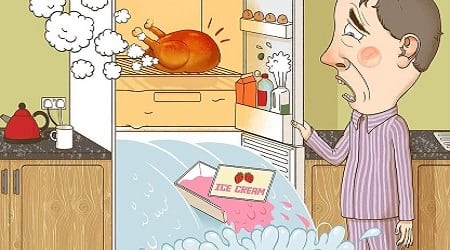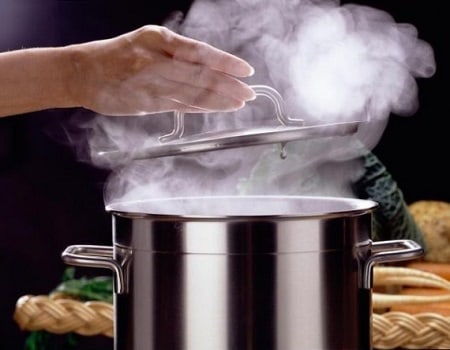The baby son came to his father and asked the baby ... “Why can’t you put hot in the fridge? My mother forbade me to put jelly! And I want it to cool down quickly! In the fridge it’ll freeze faster, dad! ”
The father, as a rule, speaks weightily: “Because he will break!” But this explanation does not satisfy the child and he simply decides that next time he will prepare jelly when there are no extra eyes at home. To explain to the child what will happen to the refrigerator, it would not hurt to know for sure why this is happening. In this review you will find out why it is impossible and what will happen if you put hot in the refrigerator.
What happens to a refrigerator if you put hot food in it?
Perhaps every adult is aware that you can’t put hot food in the refrigerator. But the children - not in the know! And every now and then strive to put hot food into it. If adults have time to notice - well, if - no, then the notorious cup with just boiled jelly appears in the cell, for example ...
And, if this is a one-time case, then global consequences, of course, will not happen. But if this happens on a regular basis, then - save up for a new unit!

Here is a list of the problems that such negligence leads to:
- The operation of the refrigerator motor for wear and its quick failure
- The formation of condensation from which a musty odor appears
- The formation of an ice crust that interferes with the operation of the condenser
- Excessive power consumption
As you can see, the last point is just nonsense, compared to the first three. Below we will explain in detail why such consequences are obtained, since it is one thing to simply know and another to understand.
See also:
- 7 best Bosch refrigerators according to customer reviews
- 8 best Samsung refrigerators according to customers
- 9 best cheap refrigerators according to customers
- 10 best LG refrigerators according to customer reviews
Why exactly does the device of the refrigeration unit
In this block we will not consider ultramodern systems in which hotter in the chamber is permissible. Such refrigerators are in nature, but due to the high price, not many people can afford this convenient thing.
So, how does a regular refrigerator work?
- Compressor - in Russian, a motor that drives a special fluid in a circle to cool products. That is, well-known freon.
- Freon is a special refrigerant that, moving in a circle, draws on itself heat from products inside
- Condenser is the part of the refrigerator at the back that removes heat to the outside.
- Evaporator - the rear, inner wall of the refrigeration unit, designed to direct heat directly to the condenser. Yes, exactly where the crust of ice forms if you forget to slam the door or set it hot.

Surely, it’s already become a little clearer to you why the overload occurs. He is simply not able to refrigerate Freon products at room temperature in the period of time that was allotted to him according to the idea of engineers.
As you know, the refrigerator does not work around the clock. It works for short periods of time and the motor starts only when the temperature in the chamber exceeds the set norm, for example, 2-5 degrees.
Then the motor comes into working condition, runs the freon in a circle, it, in turn, draws heat onto itself, gives it to the evaporator, the evaporator takes it to the condenser and the compressor, with a clear conscience, turns off. This whole process takes 10-15 minutes, not more.
But what happens if a hot product enters the chamber? The temperature inside the chamber rises excessively, freon starts to ply back and forth, but the temperature still holds. He runs and runs, but the temperature and does not think to fall ... And he is forced to run in a circle for many hours instead of the prescribed 10 minutes! Which motor can stand it?
And in the end, the life of the motor is reduced very quickly. In addition, from hard work, an ice crust forms on the back wall of the refrigerator, that is, the evaporator. And the ice crust, if you remember, keeps heat like a thermos! That is, it does not lead it to the capacitor, but holds it inside the chamber. And from this the motor overheats and the winding starts to burn ...
Can you imagine the scope of the tragedy and what is your refrigerator forced to survive? So, hopefully, now the question “Can I put hot in the fridge?” you will not arise.
![]() See also - Can I put a refrigerator near the battery?
See also - Can I put a refrigerator near the battery?
In which refrigerators it is strictly forbidden to put hotter
Naturally, in refrigerators made in the USSR. This is, first and foremost. But, there are not so many of them left, basically people have already managed to acquire more modern designs.
But, modern refrigerators are divided into those in which it is possible to put hot, and in which it is impossible categorically. The most common version of modern refrigerators is the “drip system”. That is, it is when condensate flows down on the back of the evaporator. So, to put hot in them is forbidden!

Also, there are refrigerators in which you can put, but, exclusively, in any one, specially separated chamber. The rest of the space will respond to elevated temperatures in exactly the same way as the good, old, Soviet refrigerator.
In which refrigerators can you put hot dishes
In those that are made in a tricky way that does not release heat out. Such systems are called like this:
- Westfrost
- No frost
- Grub
If you haven’t written anything like that on your refrigerator, don’t even be tempted to put hot soup for 5 minutes! If it is written, then put the warm soup in the refrigerator, but also without fanaticism. It’s one thing to put a small bowl of soup, and another is a pot of heat.
Little tricks for quick food cooling
In the summer, this is especially true. In the heat, cooked food, while cooling, manages to sour three times. To avoid this, after cooking, put the pan in a basin with cold water. As the water warms, replace it with a new portion.
But, soup is not so interesting for your children ... How, after all, can you quickly cool a glass of jelly? Since there is no handle on the glass and putting it in a large container is not so convenient, the best way to cool it to room temperature is to immerse it in hot liquid ... frozen teaspoons!
Keep 5-6 frozen spoons in stock, and notify the child about this, explaining to him popularly beforehand: “Why you can’t put hot in the refrigerator.”
See also:
- 10 best Atlant refrigerators according to owners reviews
- 10 best refrigerators from according to buyers
- 11 best BEKO refrigerators according to customer opinion
- 15 best Liebherr refrigerators according to customer reviews

